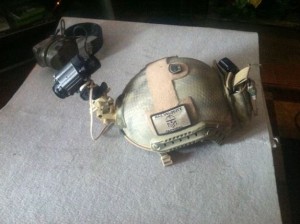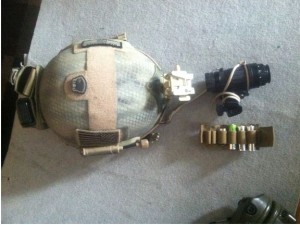Night Vision: Practical Gear Use 1 by Chris
The MVT Team pulls it out of the bag yet again. There will be follow on articles to this excellent one by Chris.
Intro by Aaron:
So with the addition of our NODF class, as well as the new NF class coming online, and a few other things in the works we need to talk about night optical devices (NODs) and how to set them up. What follows is the first in a series of articles that the cadre of MVT is going to write. You’ll notice a few things that stand out.
First is that each of our set ups will be different in a way. This does not make one set up inherently better than another. What it means is that a skilled person who is cognizant of their own needs has a thought process that works for them. There are a lot of different factors that have determined how each is set up that include, mission, experience, budget, environment etc. Don’t get hung up on the “how” but rather listen to the “why” in each article.
Second we don’t talk about things we don’t know about. You may find certain topics (methods, gear, TTPs etc.) missing in these articles. That doesn’t mean they don’t exist or that those techniques or items are not useful. It means that we likely don’t use it for our mission. All of us at MVT have lanes and we generally try to drive in them. This is all about knowledge transfer and learning. That being said this industry is still a market where people have to make money so there might be tiny gadgets and whatchamacallits who’s sole purpose is to generate revenue so be careful! Don’t be afraid to ask us questions either.
Third we’re not scientists or doctors. We are shooters, soldiers and trainers. These articles don’t get into the nuts and bolts of how a tube works or light refraction. There are plenty of articles about that and I think we all understand the theory of light amplification. In our classes we do go into much greater depth on the “how” but these articles focus on the “why” of gear set ups. This is about setting up our gear for our use to give you an idea about what can work for you. To paraphrase Heinlein in Starship Troopers, it was Juan’s understanding that some of the best violinist’s had no idea how to build a violin.
The following article was written by Chris. Stand by for other methods from Max and myself.
-Aaron
Chris sends:
Here is how I run my helmet for night operations. It’s an OPS CORE FAST ballistic helmet. The shell is constructed of carbon + UHMWPE which equates to a 20% weight reduction from ACH and MICH helmets. As anyone who has ever worn a combat helmet for long periods of time knows, this is a huge benefit. Every ounce matters, especially when you are running NODs cantilevered off your head. Even with the reduced weight, the FAST Ballistic Helmet offers the same head coverage and size as a TC2002 MICH Gunfighter helmet. The difference is the high cut sides that allow for better hearing at night, when it is most crucial. Any helmet that is used for night operations should at the very least have a 4 point chin strap. It’s the same as a bicycle vs. a 4 wheeler, it’s either a balancing act the whole time or 4 points of stability. Adjust these straps tightly! There should be no play where the helmet can move around on your head.
I have replaced the USGI rhino mount and J-arm with Norotos AKA2 helmet mount and Norotos dovetail adapter. Both these items have numerous additional adjustment features that allow the end user to put the NOD in the ideal location to look naturally forward. This is an advantage in an environment where eye fatigue and neck strain is already an issue for the user. It also eliminates the need to look slightly up or have their head tilted at an awkward angle to see clearly while on a 5 mile night movement takes much of the concentration off looking for threats and instead just trying to see where they are going. Additionally there is no movement or ‘wobble’ in this configuration that can throw off an individual’s vision if they bump a tree branch or some other obstacle. It happens.
As far as helmet accessories go, I utilize an OSE ballast pouch, which holds one MS2000M strobe and a battery strip. This system, as named, gives balance to your head to offset all the weight to the front, again lowering specific muscle fatigue and letting the user concentrate more on the mission and less on comfort. I carry all the batteries I would need to replace for my gear, in this case, 3 AAs for my Peltors and PVS-14s, and a 3 volt CR123 for my DBAL. On the right side of the helmet is a small Princeton Tec light on the rails that comes on red and if held down goes bright white. Since we are just borrowing the night sometimes you need light, but not white.
White is easily detected over long range at night. Map checks, actions on the objective, or near signaling for non NOD using allies are a couple examples. The white light can be used in CQB situations where ambient light is unavailable and you need hands free to manipulate your rifle. I do not recommend trying to do any kind of first aid on a wounded comrade in red light, it’s kind of obvious but blood is hard to see and is practically invisible in red light, even on your hands. Blue light (which you can get for your helmet light) makes blood much darker and easier to identify. Let’s be honest too, you are doing a quick blood rake or putting on a tourniquet and getting off the X, utilizing your Max Velocity TC3 class knowledge!
The PVS-14 itself has a gutted piece of 550 cord tied to it with a small Nitesize clip on the end. Anyone who has ever been to Ranger school knows you have to tie down EVERYTHING. This isn’t some annoying hazing ritual, this is because in adrenaline soaked situations where people are running, shouting and shooting, things get knocked around and you don’t want to lose your optics or sensitive items. I attach the nods directly to the helmet, as the OPS Core has retention bands in the front that easily secure it. I’ve seen troops tie their NODs to their chest harness instead of their helmet with enough cordage to have full range of motion of their head. I find this to be a disaster waiting to happen. I like a very clean ‘work space’ instead of cordage hanging in front of my face and around my gear where I need to just focus on feeding my weapon not untangling myself.
I do give myself enough cordage that, in the absence of a helmet (low profile operations) I can wear the NODs around my neck by simply taking my snap link and attaching it to the knot at the base of the PVS-14s. If the helmet comes out, I tightly wrap the cordage around the NODs (away from any operation knobs) and have just enough give for the helmet attachment.
A couple techniques I use that are open to debate, even amongst the cadre at MVT; but remember this is A WAY not THE WAY.
– I have my NODs sit over my dominant eye, in my case my right eye. Walking long distances at night, you need to be confident in your movements, and your brain has spent most of its life favoring one eye to do all the thinking, kind of like which hand you write with. If you are using DBAL/PEQ-15 type device with your weapon, that will handle all aiming you have to do. Train on this! Iron sights or optics being co-witnessed with your NODs is a wasted effort in my opinion and useless in the dark. Most optics are made these days for both eyes open so using my dominant eye to acquire a target in the dark with my non dominant eye giving me a false image because its looking down a tube will give me a terrible sight picture. NODs down, laser on or in CQB, depending on conditions, NODs up and use your optics and a light. There is a reason most SOF units use DUAL tube night vision!
– The only time I would use a non-dominant eye for my night vision is if I am using a long gun as a designated marksmen. Coming off NODs with your dominate eye then going to scope will leave your vision fuzzy and less effective for long range applications.
– One more technique I recommend, especially for new users, is a good clear lens eye protection. Walking in the woods, you only need to get whacked in the face once to appreciate having your eyes protected. Your PVS-14s should be focused about 25 meters in front of you or further so branches or eye pokers in front of your face are invisible. Eye injuries, especially in SHTF scenarios are a show stopper ‘life, limb or eyesight’ was termed that way for a reason! This also prevents self-inflicted black-eyes when bumping into things as wells as stabilizing the optic.
Ok quite the brain dump here but useful info that has helped me down range and in combat situations and training.
-Chris
For training classes:
Night Optical Device Firing (NODF)
Previous articles:


